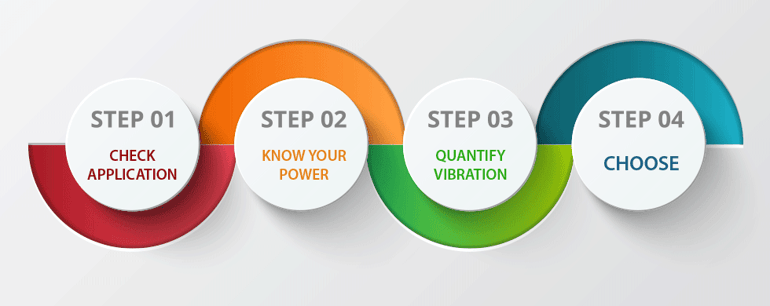Four Steps to Selecting a Piezoelectric Energy Harvesting Device
I often get asked which vibration energy harvesting device is best for various applications so I decided to put this post together based on the easy 4 step process I use.
Having designed piezoelectric harvesting devices for the past 10 years I've had lots of experience helping people select devices that are a good fit for their application. Selecting the proper harvester itself is rather simple. I should caution, designing the rest of the "system" required to do something useful with the harvested energy is a challenging problem requiring a much more in depth discussion. At the end of this post I will provide some good initial resources for designing the entire energy harvesting system. Here is the simple step by step guide to selecting the right harvester for your application.
The Four Steps to Success
Step 1: Determine If You Application Is Good For Energy Harvesting
So this step is critical. Harvesting energy is very topical and just seems like the right thing to do, but it is not appropriate for all applications. Working with many engineers and designers I've learned a lot about what makes a good application for vibration energy harvesting. The requirements for a good application are pretty simple, there needs to be a consistent vibration present (ideally fixed frequency and "reasonable" amplitude), hard wire power or battery replacement has to be not practical, and there has to be a need to sense something valuable - valuable enough to offset the additional costs associated with harvesting energy. If your application does not meet these three criteria harvesting energy from vibrations is probably not a good fit for your application.
Step 2: Know Your Power Budget - How Much Power/Energy Do You Need?
This step can get a little complicated as it encroaches on the more involved "system" design that I referenced above. However, it is important to know your general power budget so that you understand how big or how many vibration energy harvesters you require. I think an example is the easiest way to explain this: Let's say you want to measure temperature once a minute and send that information wirelessly to a node in your wireless sensor network. For easy math let's say it takes 1 second to take the measurement and 1 second to transmit the data. Let's say taking the measurement requires 10 mW of power and transmitting it takes 100 mW of power. The remaining 58 seconds the system is sleeping drawing 0.01 mW of power. So your average power draw is [(10 mW * 1 s) + (100 mW * 1s) + (0.01 mW * 58 s)] / 60 = 1.84 mW average power draw. For an energy harvester to provide enough average power it would need to provide at least 1.84 mW of average power. Ok, so know we know we need about 2 mW of continuous harvested power, next step.
Step 3: Quantify Your Vibration
In order to effectively harvest energy from vibrations you first need to understand how much vibration energy is available to harvest from. For our applications we measure the vibration using a Slam Stick X vibration data logger. We then analyze the data using a Fast Fourier Transform (FFT) to determine the dominant frequencies of the vibration. The Slam Stick X comes with free software to perform the FFT on the vibration data. Here are some basics on vibration and spectrum analysis. Once we know the frequency and amplitude of our vibration we are ready to move on to the next step.
Step 4: Choose an Energy Harvester
There are a few different vibration energy harvesting technologies to choose from, no matter which technology you use Steps 1 through 3 are the same. The technology I am most familiar with is piezoelectrics. Piezoelectric energy harvesting usually consist of a cantilevered beam that deflects under vibration loads. The piezoelectric materials then strain, converting the mechanical strain into electrical energy. The key to choosing a good piezoelectric harvester is to match the power output from the device to your power budget (Step 2: 2 mW from above). The power output will be highest when the harvester's natural frequency is matched to that of the vibration source. Again, from Step 3 we have quantified our vibration source, as a example lets say our vibration source has a dominant frequency of 60 Hz and an amplitude of 0.5 g. Choosing the best energy harvester is then a simple matter of using our data sheet to identify a product that will work for your application. Two plots from the data sheet are provided below for quick reference, these plots can be found on page 7 of the data sheet.


From the plots we see that the S128-H5FR-1107YB, S233-H5FR-1107XB and the S452-J1FR-1808XB are all capable of providing more than 2 mW of power at 60Hz and 0.5 g. However, the S128-H5FR-1107YB is the most cost effective at $13.16 per unit in volumes of 10,000 so that would be the best choice. There it is, that is how you select a piezoelectric energy harvester for your application.
Designing a Complete Energy Harvesting System
As mentioned earlier, designing a complete energy harvesting solution requires more than these four steps. A total solution will require power management, data acquisition and wireless communication, all of which will be heavily influenced by the users specific application. Linear Technology's DC2042A demo board combined with Linear's DC9003A-B Dust Mote board is a great way to integrate and test a full energy harvesting solution with different types of energy harvesting inputs. The DC2042A demo board has the LTC3588-1 energy harvesting power supply which is specifically designed for conditioning the power from a piezo.
Feel free to leave a comment with any questions. For more content on energy harvesting and all things piezo, subscribe to our blog.
Chris Ludlow
Chief Growth Officer at Mide Technology

